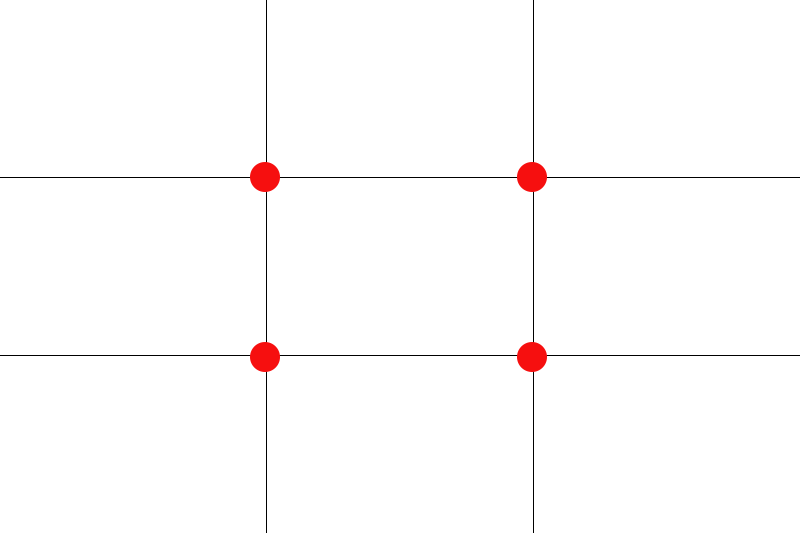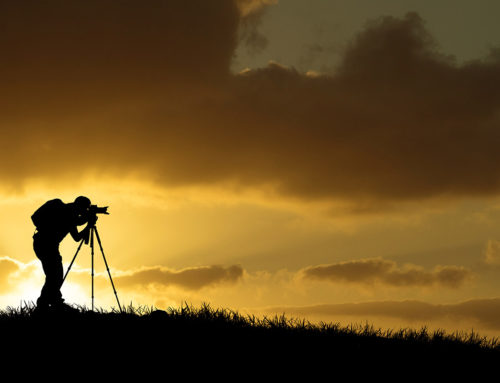While there are many different “rules” that can be used for photography composition or graphic design, the rule of thirds may be the most loved of them all. It’s a popular composition and design aid because it’s effective, and also because it’s simple. Since it’s easy to understand and easy to remember, even beginners can implement the rule of thirds and see immediate results in the quality of their work.
If you’re looking to improve your design or photography, the rule of thirds can help you to create balanced, interesting, and beautiful designs and photo compositions. Of course, like any of the other design or composition rules, this one won’t need to apply to every single design or photo. It’s just one of the many techniques that you can use.
To use the rule of thirds, you’ll visualize the design or photograph in a 3×3 grid. Some cameras even include grid lines that you can use as a visual guide when composing your photos.

The lines and intersecting points can be used as guides for the elements within the design or composition. By placing items in the right areas, you’ll wind up with a visually pleasing image.
The rule of thirds states that the important elements with the design or photograph should be aligned, at least loosely, with the grid lines. The intersection points, shown with the red circles in the image above, are the best areas to place the main focal point of the image.
The rule of thirds can be used with any type of photography and with some types of graphic design. Let’s take a look at examples using stock photos and vectors that are available here at Vecteezy.
In the photo below, the jar of flowers is aligned with one of the vertical grid lines, and the flowers are also at the top-left intersection point. Of course, with still life photography, you’re capturing objects that aren’t moving, so you’re able to take your time and get the shot lined up just the way you want.
Get millions of stock images and videos at the best price
Unlimited access. No attribution required. Starts at just $9/month.
The rule of thirds can also be extremely helpful for landscape and nature photography. In the image below, you can see that the bottom of the trees line up with the top horizontal line. In the foreground, the rocks in the water are also on or very close to the intersection points. The highest peak of the mountain also is aligned with the left vertical grid line.
Another example from a landscape photo, the photo below uses the rule of thirds to align the waterfall.
The portrait below is also an excellent example of the rule of thirds in use. Instead of being centered in the photo, the woman is lined up with the right vertical grid line and her head is at the top-right intersection. In portrait photography, the eyes are usually the focal point, and her right eye is almost exactly at the intersection of grid lines.
Below, you’ll see another portrait with a very similar alignment.
In the photo below, the man is lined up with one of the vertical grid lines, and his head is at the top-right intersection point.
Now, let’s take a look at a few examples using vectors from Vecteezy. In the wedding vector below, the bride’s body is aligned with one of the vertical grid lines, and her head is just next to the top-right intersection. The groom’s outstretched right hand is also very close to one of the intersection points.
The vector below was designed with the text in the left third of the image and the tower lined up with the right vertical grid line.
The design below uses the rule of thirds for the alignment of the woman. The headline “space exploration” also lines up with one of the intersection points.
As you can see, there are many different ways that the rule of thirds can be used. Since it’s one of the easiest design or composition rules to incorporate into your work, it’s a great option for beginners (though it is equally effective for pros).
Rules Are Made To Be Broken
Of course, the rule of thirds will not be incorporated into every design that you create or every photograph that you take. There are many other design and composition techniques that you can use, so don’t feel like every image needs to follow the rule of thirds. Use it as a guide when needed, but be willing to break the rules at times as well.
Lead image by rosshelen.













